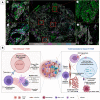Multiparameter single-cell proteomic technologies give new insights into the biology of ovarian tumors
- PMID: 36635516
- PMCID: PMC9974728
- DOI: 10.1007/s00281-022-00979-9
Multiparameter single-cell proteomic technologies give new insights into the biology of ovarian tumors
Abstract
High-grade serous ovarian cancer (HGSOC) is the most lethal gynecological malignancy. Its diagnosis at advanced stage compounded with its excessive genomic and cellular heterogeneity make curative treatment challenging. Two critical therapeutic challenges to overcome are carboplatin resistance and lack of response to immunotherapy. Carboplatin resistance results from diverse cell autonomous mechanisms which operate in different combinations within and across tumors. The lack of response to immunotherapy is highly likely to be related to an immunosuppressive HGSOC tumor microenvironment which overrides any clinical benefit. Results from a number of studies, mainly using transcriptomics, indicate that the immune tumor microenvironment (iTME) plays a role in carboplatin response. However, in patients receiving treatment, the exact mechanistic details are unclear. During the past decade, multiplex single-cell proteomic technologies have come to the forefront of biomedical research. Mass cytometry or cytometry by time-of-flight, measures up to 60 parameters in single cells that are in suspension. Multiplex cellular imaging technologies allow simultaneous measurement of up to 60 proteins in single cells with spatial resolution and interrogation of cell-cell interactions. This review suggests that functional interplay between cell autonomous responses to carboplatin and the HGSOC immune tumor microenvironment could be clarified through the application of multiplex single-cell proteomic technologies. We conclude that for better clinical care, multiplex single-cell proteomic technologies could be an integral component of multimodal biomarker development that also includes genomics and radiomics. Collection of matched samples from patients before and on treatment will be critical to the success of these efforts.
Keywords: Carboplatin resistance; Immune tumor microenvironment; Mass cytometry/CyTOF; Multimodal biomarkers; Multiplex cellular imaging; Ovarian cancer; Single cell.
© 2023. The Author(s).
Conflict of interest statement
A.A. is a co-founder of Tango Therapeutics, Azkarra Therapeutics, Ovibio Corporation, and Kytarro, a member of the board of Cytomx and Cambridge Science Corporation; is a member of the scientific advisory board of Genentech, GLAdiator, Circle, Bluestar, Earli, Ambagon, Phoenix Molecular Designs, and Trial Library; is a consultant for SPARC, ProLynx, and GSK; receives grant or research support from SPARC and AstraZeneca; and holds patents on the use of PARP inhibitors held jointly with AstraZeneca from which he has benefited financially (and may do so in the future). JDB is a cofounder and shareholder of Tailor, has had consulting and advisory roles in Astra Zeneca and Clovis Oncology, and has received honoraria from GSK and Astra Zeneca. W.J.F received an honorarium from GSK. All remaining authors have no conflicts of interest to declare.
Figures




Similar articles
-
Platinum-resistance in epithelial ovarian cancer: an interplay of epithelial-mesenchymal transition interlinked with reprogrammed metabolism.J Transl Med. 2022 Dec 3;20(1):556. doi: 10.1186/s12967-022-03776-y. J Transl Med. 2022. PMID: 36463238 Free PMC article.
-
Establishment and characterization of a platinum- and paclitaxel-resistant high grade serous ovarian carcinoma cell line.Hum Cell. 2017 Jul;30(3):226-236. doi: 10.1007/s13577-017-0162-1. Epub 2017 Mar 1. Hum Cell. 2017. PMID: 28251557
-
Oncoproteomic analysis reveals co-upregulation of RELA and STAT5 in carboplatin resistant ovarian carcinoma.PLoS One. 2010 Jun 18;5(6):e11198. doi: 10.1371/journal.pone.0011198. PLoS One. 2010. PMID: 20585448 Free PMC article.
-
Studying platinum sensitivity and resistance in high-grade serous ovarian cancer: Different models for different questions.Drug Resist Updat. 2016 Jan;24:55-69. doi: 10.1016/j.drup.2015.11.005. Epub 2015 Nov 26. Drug Resist Updat. 2016. PMID: 26830315 Review.
-
Spatial multi-omics analyses of the tumor immune microenvironment.J Biomed Sci. 2022 Nov 14;29(1):96. doi: 10.1186/s12929-022-00879-y. J Biomed Sci. 2022. PMID: 36376874 Free PMC article. Review.
Cited by
-
Harnessing the n+1 dimensions of single-cell omics data for the prediction and prevention of human diseases.Semin Immunopathol. 2023 Jan;45(1):1-2. doi: 10.1007/s00281-023-00985-5. Semin Immunopathol. 2023. PMID: 36853420 Free PMC article. No abstract available.
-
Coordinated protein modules define DNA damage responses to carboplatin at single cell resolution in human ovarian carcinoma models.bioRxiv [Preprint]. 2024 Nov 26:2024.11.21.624591. doi: 10.1101/2024.11.21.624591. bioRxiv. 2024. Update in: Cell Rep Med. 2025 Aug 19:102295. doi: 10.1016/j.xcrm.2025.102295. PMID: 39605494 Free PMC article. Updated. Preprint.
-
Advances in the Clinical Application of High-throughput Proteomics.Explor Res Hypothesis Med. 2024 Jul-Sep;9(3):209-220. doi: 10.14218/erhm.2024.00006. Epub 2024 Jul 3. Explor Res Hypothesis Med. 2024. PMID: 39148720 Free PMC article.
-
Value of ultrasound and magnetic resonance imaging combined with tumor markers in the diagnosis of ovarian tumors.World J Clin Cases. 2023 Nov 6;11(31):7553-7561. doi: 10.12998/wjcc.v11.i31.7553. World J Clin Cases. 2023. PMID: 38078133 Free PMC article.
-
Imaging-based assessment of response to olaparib in platinum-sensitive relapsed ovarian cancer patients.Front Oncol. 2025 Jun 5;15:1546324. doi: 10.3389/fonc.2025.1546324. eCollection 2025. Front Oncol. 2025. PMID: 40538854 Free PMC article.
References
Publication types
MeSH terms
Substances
Grants and funding
LinkOut - more resources
Full Text Sources
Medical
Miscellaneous

